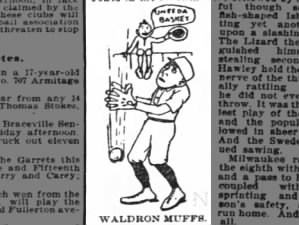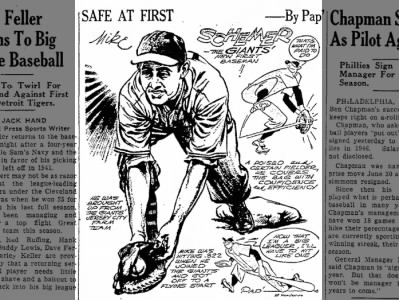I was struck perusing Baseball-Reference.com on Saturday to see Pete Rose had -13.7 Wins Above Average over his final seven seasons, 1980 through 1986. It’s long been well-known Rose stuck around a few seasons longer than he maybe should have as he chased the all-time hits record. Rose got 884 hits those final seven seasons, passing Honus Wagner, Cap Anson, Tris Speaker, Stan Musial, Hank Aaron and finally Ty Cobb on the hits list. But those seasons cost Rose in other ways.
If Rose had retired at 38 after the 1979 season, he’d rank 49th all-time with 42.3 WAA; instead, he’s tied for 130th at 28.6. He’d also be two hits shy of averaging 200 hits a season for his career and likely would have been ushered into the Hall of Fame in 1985, four years before his lifetime ban for betting on baseball. In more ways than maybe any other player in baseball history, Rose’s career and life is a story of not knowing when to quit. Ironically, it’s the same compulsive drive that made him great.
By Wins Above Average, Rose’s final seven seasons rank 29th-worst among position players in modern baseball history. With the help of the Baseball-Reference.com Play Index tool, here are the 29 worst seven-season runs by position players since 1900:
- Bill Bergen, -14.3 WAA, 1901-1907
- Bill Bergen, -14 WAA, 1902-1908
- Bill Bergen, -14.9 WAA, 1903-1909
- Bill Bergen, -16 WAA, 1904-1910
- Bill Bergen, -16.3 WAA, 1905-1911
- Ralph Young, -14 WAA, 1916-1922
- Walter Holke, -13.8 WAA, 1918-1924
- Walter Holke, -14.7 WAA, 1919-1925
- Chick Galloway, -15.3 WAA, 1920-1926
- Tommy Thevenow, -13.8 WAA, 1928-1934
- Tommy Thevenow, -15.6 WAA, 1929-1935
- Tommy Thevenow, -14 WAA, 1930-1936
- Doc Cramer, -15.8 WAA, 1936-1942
- Doc Cramer, -13.8 WAA, 1937-1943
- Ken Reitz, -15 WAA, 1973-1979
- Ken Reitz, -16.2 WAA, 1974-1980
- Jerry Morales, -15.3 WAA, 1974-1980
- Dan Meyer, -14.3 WAA, 1974-1980
- Ken Reitz, -15.7 WAA, 1975-1981
- Dan Meyer, -15.4 WAA, 1975-1981
- Jerry Morales, -14.9 WAA, 1975-1981
- Doug Flynn, -15.9 WAA, 1976-1982
- Dan Meyer, -14.1 WAA, 1976-1982
- Doug Flynn, -17.6 WAA, 1977-1983
- Dan Meyer, -14.7 WAA, 1977-1983
- Doug Flynn, -17 WAA, 1978-1984
- Doug Flynn, -14.7 WAA, 1979-1985
- Pete Rose, -13.7 WAA, 1980-1986
- Yuniesky Betancourt, -16.7 WAA, 2007-2013
There’s another side to this that I’d be remiss to not mention. For one thing, Rose’s WAA would be higher had he not played first base for the Phillies. According to this page of Baseball-Reference.com, which @LoveSportsFacts showed me on Twitter, WAR sets average offensive production for first basemen at .797 OPS. It’s set at .707 for third base, Rose’s position before he signed with the Phillies in December 1978. Assuming Rose had been able to keep playing the bulk of his innings at third, his .687 OPS from 1980 through 1986 would be close to average for the position. It seems a little unfair to penalize Rose, given that he switched positions to accommodate Mike Schmidt.
Rose’s greatest value may have come in the clubhouse, which makes me wonder why he didn’t manage Philadelphia, which had four skippers during his five seasons in town. Dan Mallon shared a few pages with me via Twitter from the 2013 book Almost a Dynasty: The Rise and Fall of the 1980 Phillies, which describes Rose’s immediate impact in Philadelphia. This included Rose diverting attention away from Schmidt by grandstanding with the press, “a wonderful salesman for the team almost from the beginning of his tenure.” He also helped build Schmidt and other teammates’ confidence. The book includes a quote from Schmidt, who said of Rose:
In 1980, Pete provided the kind of dynamic leadership that took the pressure off the other players. He was the finest team player I had ever seen. He always had something to say to pump you up, to play harder every game. At the same time, he was the kind of athlete who was boastful and could go out on the field and back it up. That allowed the rest of us to raise our level of play and ultimately go on to win the World Series.
Mallon told me Rose that Schmidt, like Phillies teammates Larry Bowa and the late Tug McGraw and manager Dallas Green have all publicly credited Rose for getting Philadelphia over the hump to win its first World Series in 1980. After all when Rose joined the Phillies as a free agent in December 1978, the team was coming off three consecutive years losing the National League Championship Series. As a player, Rose was worth -2.8 WAA in 1980. Given the outcome that year, the point is moot.
It’s a different story for 1983, where 42-year-old Rose hit .245, was worth -4 Wins Above Average and struggled to keep his starting spot. Nicknamed “The Wheeze Kids” at an MLB-high 31.8 years average age that season, Philadelphia somehow made a pennant run. Rose hit .345 in the playoffs, but the Phillies lost to Baltimore 4-1 in the World Series and released Rose one week later. Roger Angell wrote of it, “It is painful for us to see old players go, and infinitely harder when they prolong the inevitable process.” Bill James wrote in his 1984 abstract, by which point Rose had signed with the Montreal Expos:
Pete’s selfishness in sacrificing the good of his team to forge on in sub-mediocrity after his own goals is, in its own way, what you would expect from a spoiled beauty. It’s a sad way to end a distinguished career, but you’ll do us both a favor if you’ll just pull the plug on it, and let him get his 4,000th hit two years from now in an empty parking garage in a dark corner of the nation, at a far remove from the pennant race.
Baseball, of course, did nothing of the sort with a seven-minute celebration and new Corvette presented on field when Rose got his record on September 11, 1985.

